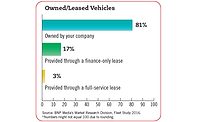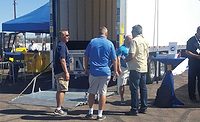Fleet Maintenance Trends
David Kolman
New vehicles, engines, components and the uncertainty that goes along with any new truck technology is impacting equipment maintenance. Nevertheless, the goal of vehicle maintenance management remains unchanged: to come up with the best possible measures to maintain and service a vehicle to ensure maximum energy efficiency, optimum engine performance, the most efficient productivity and longest vehicle life.
Here is a look at some of today’s fleet
maintenance trends:
Full-Service Leasing — Any time a new technology is introduced in trucks, there is an
increased interest in full-service leasing. The reason: it can insulate
truck users from the uncertainty that goes along with new technology and
truck ownership. Plus, full-service leasing companies typically have
technicians trained in the new technology that handle vehicle maintenance
and emergency roadside service.
Telematics — The use
of telematics in vehicles is growing. Basically, telematics integrates
computing, electronic and wireless communication technologies. Vehicle
telematics systems are being used for such functions as real-time GPS
(Global Positioning System) vehicle tracking and positioning, navigation,
route optimization, dispatcher/ driver communications, mileage reporting,
toll-paying and remote vehicle monitoring and diagnostics.
Vehicle Life-Cycles — With the continued development of more reliable, longer-lasting
components, combined with the increase in total vehicle maintenance
management tools that allow specifically tailored maintenance programs,
fleets are extending their vehicle replacement cycles.
Maintenance — The
improvement in vehicle engineering and quality continues to lead to
decreased need for routine maintenance intervals and oil changes. With
advances in on-board technology, systems generate and store data, monitor
certain vehicle operating parameters and alert the driver to problems, plus
keep track of when scheduled maintenance is due.
Maintenance Information and Resources — As more powerful processing technology becomes available at
continually decreasing costs, fleets are increasingly developing and
implementing more advanced vehicle maintenance and service recordkeeping
systems and integrating them with improved fleet management systems. With
better information, they are gaining significant opportunities to improve
operations and make cost-effective decisions about whether to repair,
overhaul or replace vehicles.
Hybrid and Alternative Fueled Vehicles — The service and maintenance of these vehicles will become
more of an issue as greater numbers of them come into use. A hybrid vehicle
is one that combines two or more sources of power that can directly or
indirectly provide propulsion power. Alternative fuel vehicles run on a
number of non-petroleum-based fuels, including biodiesel, electricity,
methanol, ethanol, compressed natural gas and propane or liquefied
petroleum gas (LPG). Technicians will require additional training and new
tools to work on these vehicles, which can have such unique systems and
components.
Technology — Keeping
pace with changes in equipment, technology and legislation is becoming a
greater challenge. So, too, is the challenge to keep the existing workforce
up to par with required skills, and modifying the selection criteria used
in recruiting new employees.
Lifecycle Costing — As
fleets collect better information on maintenance and operating expenses,
vehicle lifecycle costing is taking on greater significance. Lifecycle cost
analysis is a process for evaluating the total economic cost of vehicle
ownership, taking into account all costs of acquiring, owning and disposing
of a vehicle over its useful fleet life.
Technicians — Fleets
continue to deal with a shortage of qualified technicians, and the
situation will become worse due to the demographic trends that underlie the
surge in demand. Experienced service technicians are retiring as fewer
people are choosing vehicle service as a career.
Keep in mind that vehicle maintenance begins when
buying new equipment. The choices you make at the beginning of a
vehicle’s life — selecting the appropriate make, model,
components, accessories, body and equipment for the particular application.
Then, for maximum uptime and lower overall lifecycle costs, set up —
and keep — an effective preventive maintenance program. BI
David Kolman is a veteran truck communicator, keynote
speaker and long-haul trucker. Commissioned as an Honorary Colonel on the
Kentucky governor’s staff for his work promoting traffic safety, he
actively participates in trade associations and reports news and
information about the trucking industry for broadcasting and print media.
Equipment news roundup
Kenworth introduced its
new K260 medium-duty cabover, a non-CDL truck with a gross vehicle weight
rating (GVWR) of 26,000 pounds.
The K260 has 63.2-inch bumper to back of cab (BBC)
dimension and is available in wheelbases of 189 and 210 inches, with either
an air or mechanical suspension. Its spacious 92.5-inch-wide cab easily
accommodates three. Doors open 90 degrees for comfortable entry/egress.
Power is supplied by a 220-horsepower PACCAR PX-6
5.9-liter diesel engine backed to a ZF overdrive six-speed transmission.
Axles are rated for 26,000 pounds — front 10,000
pounds; rear 21,000 pounds (4.56 ratio). Air disc brakes are positioned at
the front and rear.


